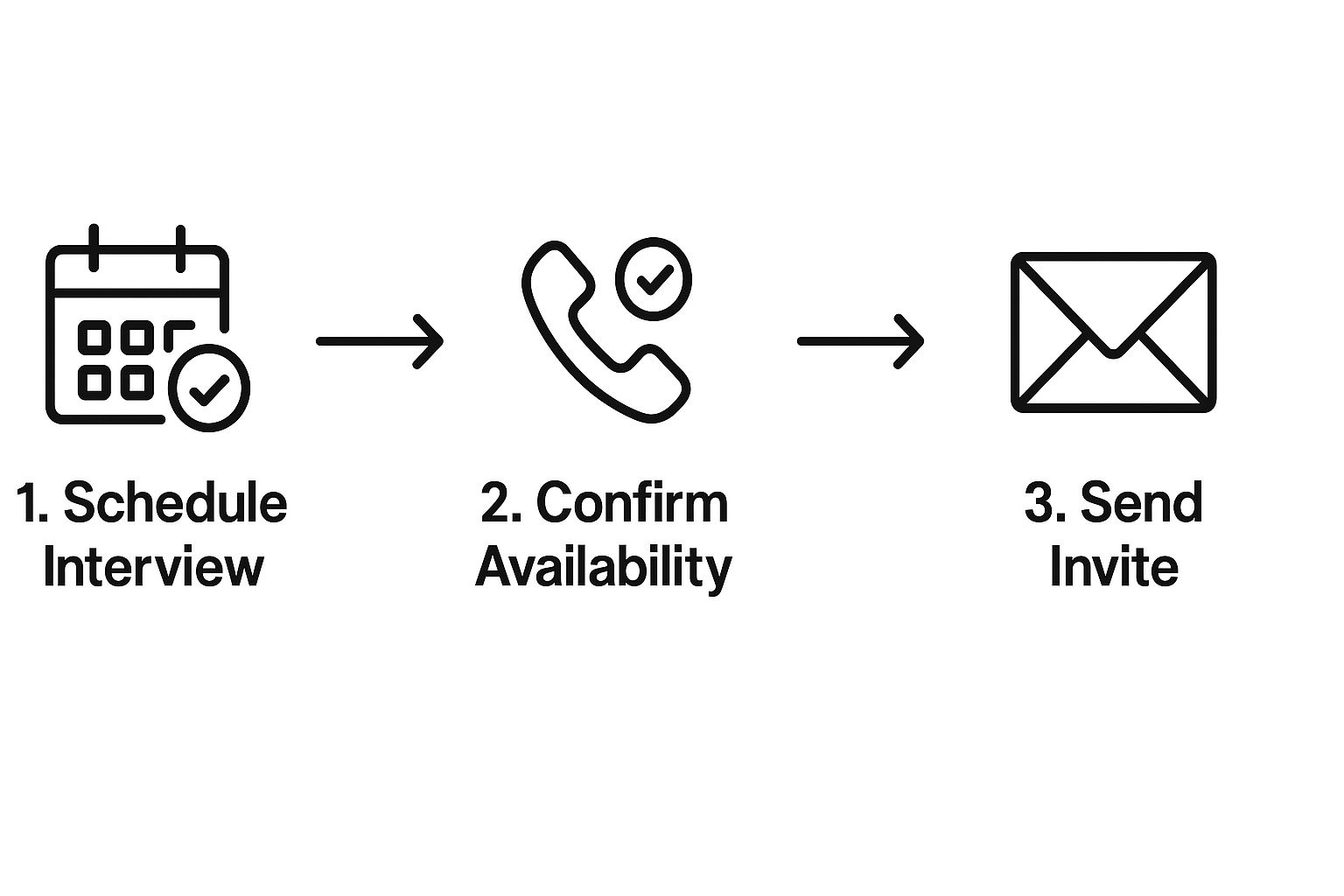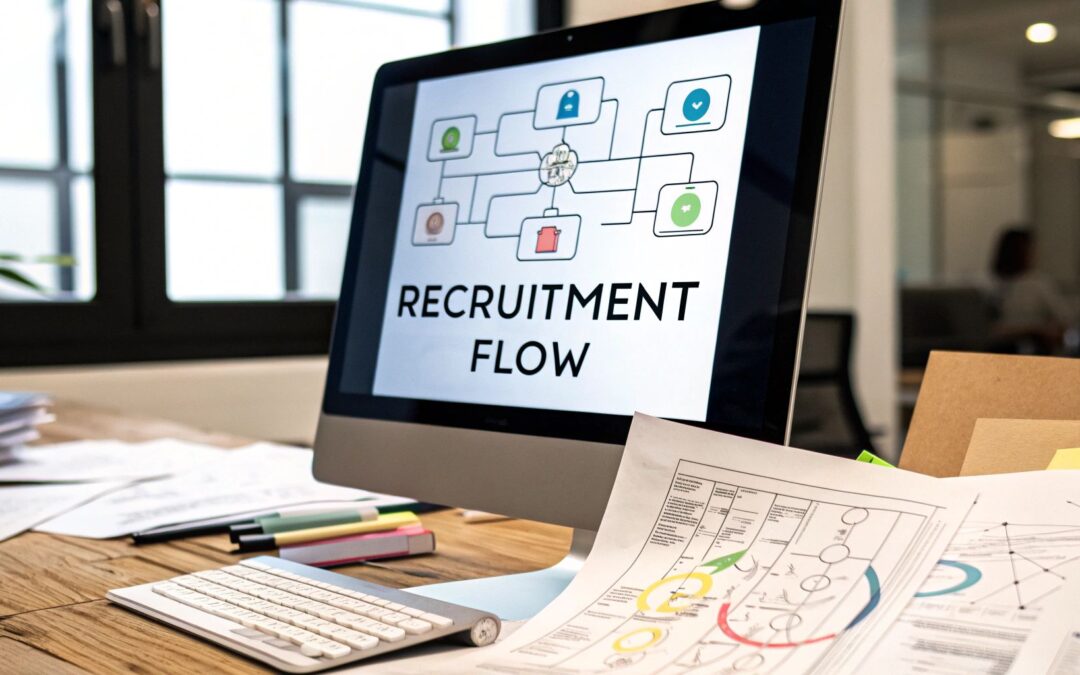A recruitment process flow chart is essentially your hiring playbook in a visual format. It maps out every single step, from the moment you realize you need to hire someone all the way to their first day on the job. The real value here is that it standardizes your workflow, promotes fairness for every candidate, and gives recruiters and hiring managers a clear, shared roadmap to follow.
Why a Flow Chart Is Your Hiring Superpower

Let's face it—hiring can get chaotic. Without a solid plan, teams often end up putting out fires instead of proactively managing the process. This is where a well-thought-out recruitment flow chart stops being just another document and becomes a genuine strategic tool, bringing much-needed clarity and consistency to how you find and hire talent.
Think of it as the GPS for your entire hiring journey. It clearly shows everyone the route from point A (the job requisition) to point B (a new team member starting their role). This visual guide ensures that every person involved knows exactly what their responsibilities are at each stage, which drastically cuts down on miscommunication and costly delays.
Align Your Entire Hiring Team
One of the biggest wins is creating a single source of truth for everyone. When the HR team, the hiring manager, and the interview panel are all working from the same visual playbook, alignment just clicks into place. Everyone knows what’s supposed to happen next, who owns that action, and what the general timeline looks like.
This shared understanding is absolutely crucial for creating a smooth and professional candidate experience. A consistent, well-oiled process shows you respect a candidate’s time, which goes a long way in building trust and boosting your employer brand.
Spot Inefficiencies Before They Hurt You
A flow chart is fantastic for making bottlenecks stick out like a sore thumb. Is there a long, unexplained gap between the phone screen and the first real interview? Are you losing great candidates after a particular skills test? Visualizing the entire workflow helps you pinpoint these weak spots so you can make smart, data-driven fixes to keep things moving.
In a market this competitive, speed and efficiency are everything. According to the Society for Human Resource Management (SHRM), a staggering 77% of organizations report significant recruitment challenges, from not getting enough applicants to facing intense competition. A refined process helps you act faster and lock in top talent before someone else does. You can find more insightful recruitment statistics to see just how critical this is.
Key Takeaway: A recruitment process flow chart transforms hiring from a string of disconnected tasks into a cohesive, manageable system. It's the foundation for slashing your time-to-hire, improving the quality of your candidates, and ultimately, making much smarter hiring decisions.
Laying the Groundwork Before You Recruit

Let's be honest, a good hire is made long before you ever post a job ad. The real magic happens in the planning phase. This is the bedrock of your entire recruitment process flow chart, and skipping it is the fastest way to make costly mistakes down the line.
I've seen it happen too many times: a team gets excited and rushes straight into writing a job description without a real plan. This always leads to a vague search that attracts a flood of applicants who just aren't the right fit, wasting everyone's time.
Define the Ideal Candidate Persona
Before you even think about a job description, grab the hiring manager and have a real conversation. Your goal here isn't just to list a few skills; you need to build a detailed candidate persona. Think of it as a semi-fictional profile of the exact person you're looking for, covering everything from their skills to their motivations and work style.
Get specific. Ask questions that dig deeper than the surface:
- What's the first big problem this person needs to solve in their first 90 days?
- What soft skills are absolutely non-negotiable for this specific team's dynamic?
- Have we noticed that people from certain professional backgrounds tend to really click with our company culture?
Getting on the same page from the very beginning is crucial. This collaborative effort turns a generic job description into a magnetic document that speaks directly to the professionals you actually want to hire.
Your candidate persona is your North Star. It doesn’t just guide your sourcing strategy; it shapes your interview questions and evaluation criteria, creating a consistent and fair process for everyone.
Standardize Your Job Requisition Process
Once you know who you’re looking for, you need a formal process to get the green light to find them. This is where a standardized job requisition comes in. Think of it as the official starting pistol for your recruitment flow chart, a formal request that locks in all the essential details.
Make this form a mandatory first step. It forces every stakeholder to stop and think through the critical aspects of the role before the search officially begins.
This document should clearly outline:
- Role Justification: Why do we absolutely need this position right now?
- Budgetary Approval: What is the approved salary range, and do we have the budget?
- Key Performance Indicators (KPIs): How will we know if this person is succeeding six months from now?
- Interview Panel: Who are the key decision-makers that must be involved in the interview process?
Getting all of this confirmed upfront prevents those frustrating last-minute changes that can completely derail a great candidate's experience. A little investment in planning here builds a solid foundation, making every other stage of the hiring process run that much smoother. It's about getting everyone aligned on expectations from day one.
Mapping Your Core Hiring Workflow
With all the prep work done, it's time to bring your hiring journey to life. This is where your recruitment process flow chart stops being a plan and becomes a living, breathing map for your team. It guides everyone from the moment you start looking for candidates all the way through to making a competitive offer. The real goal here is to build a clear, repeatable workflow that’s impossible to misunderstand.
A strong process always kicks off with a solid, multi-channel sourcing strategy. Don't just post on a job board and hope for the best. Your map needs to show how you'll find those hidden gems—the passive talent. This means creating specific paths for LinkedIn outreach, leaning on your employee referral programs, and getting active in niche online communities. Each channel should look like a separate stream feeding into your main applicant pool.
Structuring the Screening and Interview Loop
As soon as applications begin to flow in, your chart needs to lay out the screening process in detail. The first gate is usually an automated resume scan by an Applicant Tracking System (ATS). It’s a huge time-saver, filtering for essential keywords and qualifications, but it’s not foolproof and always needs a human eye to double-check its work.
Next up is the initial phone screen. Your flowchart should be specific here:
- Who owns this? Is it a dedicated recruiter or an HR generalist?
- What are we asking? Define a short, standardized script to confirm experience, check salary expectations, and get a first impression of their personality.
- What's the outcome? It has to be a clear "go" or "no-go" for the formal interview loop.
From that point, you'll map out the actual interview stages. A common trap is to have a single, generic "Interview" box on the chart. That’s not nearly enough detail. Break it down.
- Behavioral Interview: This is typically the hiring manager’s domain, where they dig into past performance and see how a candidate solves problems.
- Technical Assessment: A hands-on test or a session with senior engineers to prove they have the hard skills.
- Panel Interview: This brings in key team members and stakeholders to see how the candidate gels with the team and fits into the wider company culture.
Your flow chart should explicitly name the roles or even the specific people involved in each stage. If you need a good starting point for structuring all this, a well-designed hiring process template can be incredibly helpful.
Below is a simple look at the administrative tasks that go into just setting up these interviews.

It just goes to show how even the small, repeatable steps need to be clearly defined within the bigger picture.
From Final Checks to the Job Offer
After the last interview, the process still needs structure. You’re now in the final stages, which include any last-minute assessments and, of course, reference checks. Your chart should pinpoint exactly when these happen—usually after the final interview but before an official offer goes out. It should also designate who is responsible for gathering all the feedback and making the final hiring decision.
The offer stage isn’t just a quick phone call. Think of it as a mini-process in itself. It should be documented as a verbal conversation followed immediately by a formal written offer letter that covers salary, benefits, start date, and all the important details.
Finally, you need to map out the decision points. What happens next? If the candidate says "yes," the flow chart should point directly to your onboarding process. But if they decline, the chart needs a loop that takes you back to the next-best candidate. This simple step prevents your team from having to restart the entire search from square one.
Comparing Old vs. New Recruitment Workflows
To see how far things have come, let's compare the rigid, old-school way of hiring with the more fluid, candidate-centric approach a modern flow chart enables.
| Stage | Traditional Approach | Modern Approach |
|---|---|---|
| Sourcing | Post a job ad, wait for applicants. | Proactively search on multiple channels, including passive talent. |
| Screening | Manual resume review, often inconsistent. | ATS pre-screening followed by a standardized phone screen. |
| Interviews | A single, long interview with the hiring manager. | Multiple, specialized interviews (behavioral, technical, panel). |
| Decision-Making | Hiring manager makes a gut decision. | Collaborative feedback from all interviewers, data-informed. |
| Candidate Status | Little to no communication with the candidate. | Regular, automated updates at each stage. |
| Offer | A verbal offer with details to follow. | A formal, comprehensive offer letter sent promptly. |
| Rejection | Candidate is "ghosted" or receives a generic email. | Personalized feedback and invitation to stay in the talent pool. |
This shift isn't just about being more organized; it's about creating a better experience for everyone involved and ultimately making better hires.
Interestingly, many teams are now building their own tools to automate parts of this workflow, often with very little coding required. To learn more, check out our guide on the uses and applications of low-code no-code AI platforms.
Weaving Smart Tech into Your Hiring Process
Let's be real: modernizing your recruitment flow chart is all about bringing in the right tech to handle the grunt work. The idea isn't to let robots do the hiring. It's about automating the administrative headaches that bog down your team, so they can focus on what people do best—connecting with great candidates.
Think of it as giving your recruiters superpowers. Instead of drowning in a sea of resumes, an Applicant Tracking System (ATS) can do the first pass, instantly flagging candidates who tick the essential boxes. Getting a handle on a powerful system to manage candidate data and organize your hiring stages is a game-changer. If you want to dig deeper, this guide on Mastering Your Job Application Tracking System is a great resource.
Where Can Automation Make the Biggest Impact?
You'll find a few spots in your hiring workflow that are practically begging for a tech upgrade. Dropping the right tools into these stages can slash your time-to-hire and make your process way more consistent.
- Candidate Sourcing: AI tools can be your secret weapon here. They can scout professional networks and databases to find those hidden gems—passive candidates who fit your ideal profile but aren't actively looking.
- Interview Scheduling: Stop the email ping-pong. Automated scheduling tools connect to your team's calendars and let candidates pick a slot that works for everyone. It's a simple fix that saves hours.
- Screening and Assessment: When you're dealing with a flood of applicants, tech can be a lifesaver. Beyond just parsing resumes, some platforms use AI-powered skills tests or chatbot screeners to handle the initial wave.
These kinds of integrations are a perfect example of smart business process automation, a strategy that brings efficiency to all corners of a company, not just HR.
Don't Lose the Human Touch
While automation is fantastic, you have to keep your process human. Technology should inform your decisions, not make them for you. An ATS might filter out a resume because it's missing a specific keyword, but it takes a sharp recruiter to see the potential in someone with a non-traditional background.
It's a fascinating balance. A recent report found that while nearly 99% of hiring managers use AI to make recruiting more efficient, 93% of them insist that human oversight is essential for interpreting the data and making the final call. You can check out the full AI in hiring report to see how leaders are thinking about this.
At the end of the day, your recruitment flow chart should champion a hybrid approach. Use tech for what it's good at: managing data, scheduling interviews, and handling volume. That frees up your people to do what they're good at: judging culture fit, conducting meaningful conversations, and convincing your top candidate that your company is the right place for them. The best systems blend tech-driven efficiency with genuine human connection.
Don't Stop at the Offer: What Happens Next Matters

It’s easy to feel like you've crossed the finish line once a candidate accepts your job offer. But in reality, the race isn’t over. That period between the "yes" and their first day is a fragile time. This is when your top choice is most likely to get a counteroffer or simply get cold feet.
To prevent those frustrating last-minute drop-offs, your recruitment flow chart needs to extend beyond the offer letter. Map out a clear engagement plan for this crucial waiting period. It's not about overwhelming them with forms. Think smaller, more personal touches.
A quick welcome email from their direct manager or a short video message from the team can go a long way in making them feel like part of the company before they even start. It reinforces their decision and keeps the excitement alive.
From Diagram to Data-Driven Tool
A truly effective flow chart is more than just a map of your process—it’s a launchpad for making that process better. The post-hire stage is the perfect time to gather the data you need to spot weaknesses and double down on what’s working. This is how your chart becomes a living tool for continuous improvement.
You don't need to track a hundred different things. Start with a few core recruitment metrics for every single hire:
- Time-to-Fill: How long did it take, from the moment the job was approved to the day the offer was accepted? If this number is consistently high, you might have a bottleneck somewhere, like in interview scheduling or getting approvals.
- Cost-per-Hire: Tally up everything you spent to fill the role, from job board ads to recruiter time. This metric is crucial for figuring out which sourcing channels actually give you the best return on investment.
- Quality-of-Hire: This one is the ultimate gut-check for your entire process. Usually, you measure it by looking at the new hire’s performance review scores after their first 90 days. Are they meeting or exceeding expectations?
When you start analyzing this data, real patterns emerge. Maybe your Quality-of-Hire is fantastic, but your Time-to-Fill is painfully long. That could tell you your process is thorough but maybe a little too slow. Getting comfortable with data-driven decision-making is what turns these observations into a concrete strategy for getting better.
Building a Cycle of Improvement
Leaning on data isn't just a "nice-to-have" anymore; it's essential for staying competitive. Companies that get this right see incredible results. Many have cut their time-to-hire by up to 40% while seeing a 71% boost in candidate quality.
So, what's the secret? It often comes down to better communication. In fact, 40% of talent leaders pinpoint communication as their primary focus for keeping candidates from dropping out. You can explore more recruiting statistics and insights to see just how big of an impact these small changes can make.
Final Takeaway: Treat your recruitment process flow chart as a dynamic blueprint, not a static document. By carefully planning your post-offer engagement and consistently digging into your performance data, you create a powerful feedback loop. This cycle doesn't just help you land top talent—it makes your entire hiring engine smarter, faster, and more effective over time.
Have Questions About Your Recruitment Flow Chart? You're Not Alone.
Even with a solid plan, a few questions always come up when you're in the trenches, trying to map out or improve your hiring process. Let's dig into some of the most common ones I hear. Getting these right can be the difference between a flow chart that just looks good on a slide and one that actually works.
It's easy to get overwhelmed by all the moving parts, so a lot of people start by asking where to put their focus.
What's the Single Most Important Stage to Get Right?
Every stage matters, but if I had to pick one, it’s the very first one: Laying the Groundwork.
Think of it this way—if the foundation of a house is crooked, it doesn't matter how great the rest of the construction is. The whole thing will be unstable. The same is true for hiring.
If you don't sit down with the hiring manager and hammer out a crystal-clear job description and candidate persona, you're setting yourself up for failure. A fuzzy start guarantees a pipeline full of mismatched candidates, interviews that go nowhere, and a much higher chance of making a bad hire. When you nail this initial alignment, everything that follows becomes smoother and more effective.
How Often Should I Bother Updating This Thing?
Your recruitment flow chart should be a living, breathing document, not a "set it and forget it" project. It needs to adapt as your company and the talent market change.
As a general rule, I recommend a formal review at least once a year. But don't wait for the calendar reminder if you see trouble brewing. If your time-to-fill is creeping up, offer acceptance rates are dipping, or you're getting negative feedback on the candidate experience, it's time to open up the chart and see what's broken.
Other great reasons to revisit your process include:
- New Tech: Just rolled out a new Applicant Tracking System (ATS) or automation tool? Your workflow has definitely changed, so your chart needs to reflect that.
- Company Direction: If the business suddenly pivots and starts hiring for completely different roles, your old process might not cut it.
- Market Swings: In a hot talent market, a slow, clunky process will cost you the best candidates. You might need to speed things up or change how you source people.
Basically, let your hiring data tell you when it's time for a tune-up. That's the smartest way to stay ahead.
What Are the Best Free Tools for Making a Flow Chart?
Good news: you don't need to spend a dime on fancy software to map out a great hiring process. There are plenty of fantastic free tools that work just fine.
For real-time collaboration with your team, Miro and Lucidchart are my top picks. They both have generous free versions with pre-built templates that make it easy to get started. If you just need something quick and simple, Google Drawings (part of the free Google Workspace) is surprisingly capable. You can even use a design tool like Canva to create a visually sharp flow chart.
Honestly, the "best" tool is whichever one your team will actually use.
How Can I Make Our Flow Chart More About the Candidate?
This is a great question. Shifting the focus from your internal steps to the candidate's journey is a game-changer.
The key is to map out every single communication touchpoint. For each stage—from "Application Received" to "Offer Extended" and especially "Rejection"—define exactly what you're going to say and when you're going to say it. No more black holes.
You should also build in moments to ask for feedback, like a quick two-question survey after the final interview. Set realistic timelines for the process and share them upfront with candidates. A candidate-centric flow chart is all about showing respect for their time and energy. It leaves a positive impression of your company, even for the people you don't end up hiring.
At Zilo AI, we know that a solid, repeatable process is the backbone of great hiring. Our manpower and data annotation services are built to plug directly into your workflow, giving you the skilled people you need to grow your teams without the friction. See how we can support your hiring goals by visiting us at https://ziloservices.com.

